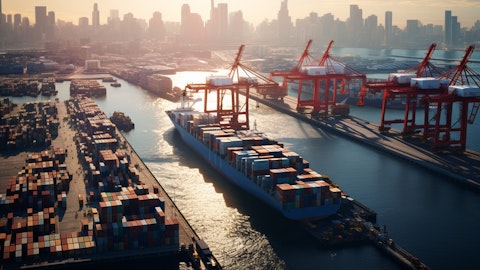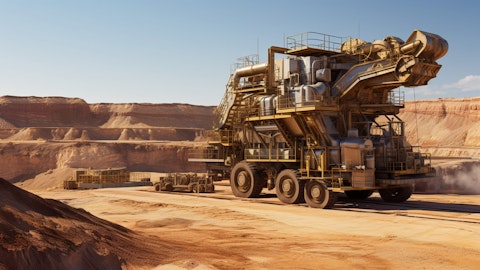Contango Ore, Inc. (AMEX:CTGO) Q3 2025 Earnings Call Transcript November 14, 2025
Romeo Maione: Good evening, wherever you’re tuning in from today. I personally am joined live at Deutsche Goldmesse in Frankfurt, Germany by Contango CEO, Rick Van Nieuwenhuyse; and CFO, Mike Clark, to discuss Contango’s Q3 reporting. Gentlemen, how are you?
Rick Van Nieuwenhuyse: Good to see you here in Frankfurt, Romeo.

Romeo Maione: Awesome. And I wish we’re in the same room, but we’re several feet away just because of the practicalities of movie magic on webinars. But here’s how today is going to work just for the folks in the room. I’ve got a number of questions to go through, just eager to get into these pretty great Q3 reports. And then I’m eager to take questions from the live audience. So if there is any questions that you got during today’s event, there is chat button in the bottom right of your screen. Please jump in at any time. Anything I don’t get to, we’re going to be a pretty short event today. But any questions I don’t get to, I’ll be sure to get to both Rick and Mike and the Contango team afterwards, and they’ll be able to get back to you as quickly as possible.
Romeo Maione: I wanted to jump right into the protein as quickly as I can. Rick, obviously, looking at record operating income of $25 million this quarter, while I think almost as impressively or more impressively maintaining AISC below that $1,625 target at $1,597 per ounce. So 2 comment and a question. First, that’s a lot of money. Congratulations. And what’s kept ASIC in check?
Rick Van Nieuwenhuyse: Well, I think, yes, it’s a lot of money. It’s a record for us. That was our Q3 production level was above plan by about 2,000 ounces. And importantly, the AISC is coming in lower than the 1,625 that we guided to. And obviously, we got our guidance from Kinross. So I think a big reason behind that is we’re — the mine plan that we outlined, we’re delivering into or exceeding that. And I think that’s somewhat typical of Kinross as a big company. They like to underpromise and overdeliver. That’s good because that means we’re not going to get too far ahead of our skis. And I think the other thing overall that we see that’s really helped our project specifically is the fact that the oil price is low and diesel prices have not gone up.
Q&A Session
Follow Contango Ore Inc. (AMEX:CTGO)
Follow Contango Ore Inc. (AMEX:CTGO)
Receive real-time insider trading and news alerts
We all know that an increasing gold price environment is telling us that inflation is still there regardless of what the government officially tells us. We know that’s what it is anticipating. But this — what is different about this time around is that we don’t see that going — the oil prices going up in Alaska. We’ve had the same pretty stable diesel price at the pumps for several years now. So that’s a good thing. It’s specifically a good thing for our projects, obviously, with the transportation aspect of transporting the ore from the mine site to the mill, it’s a significant part of our cost structure. So I think that — and I think the other thing is, look, Kinross is doing a great job just delivering into the plan that they’ve outlined.
So when you’re kind of firing on all cylinders is the way I like to express it.
Romeo Maione: No, makes a lot of sense. And Mike, I want to get you in here for some of the dollars and cents questions. I know the cash position jumped from $20 million at year-end 2024 to an eye-popping $107 million as of September 30, with $87 million distribution received from that Peak Gold JV to date. I hope you could walk us through just capital allocation priorities. So now you’ve paid down a bunch of debt, you settled carry trade. What’s the strategic thinking behind those moves?
J. Clark: Yes, it hasn’t changed much from the last couple of periods. Our objective all along has been to deliver into the hedges, get those paid off as quickly as possible, pay down the debt on schedule. And so to date, we’ve had — we’re always about a quarter ahead on our production. So we’re always delivering about 3 months in advance. And so that’s why we’re using the carry trade in a rising gold market, that has saved us. I think this quarter, we saved about $2.4 million as a result. So the strategy is working. And so we’re going to continue doing that. I think we’re delivering the December hedges right now. And the goal is we’ll basically try to get these delivered into you all by September of next year. So we’re waiting for the ’26 plan for Manh Choh, but that is currently what our target is internally.
Romeo Maione: No, I appreciate that. And Mike, one thing I noticed you added adjusted net income this period. Just for folks in the room and for me, too, to be honest, can you provide some insight into that? What are we looking at here?
J. Clark: Yes. You can thank Rick for that last minute. Basically, we continue to report a very strong income statement, and you keep having these derivative hedge losses that kind of muddy the waters. And really what that is, is an unrealized loss on the derivatives, which is a function of the forward curve of the gold price. And because it went up so much in September up to like $4,300, the derivative loss went way up. And so that had a $30 million impact on our P&L, which took us from what really would be a normal reoccurring net income position to a net loss. So we put it in there so that shareholders could kind of see what the business would look like once those things are gone and what our normal business looks like. Rick, anything to add to that?
Rick Van Nieuwenhuyse: Yes, I’ll just add kind of I find the accounting rules somewhat inaccurate when they’re describing this and how they sort of force describe things. So it’s unrealized, meaning that if we don’t deliver that gold and future gold, yes, we’re in trouble. We’ve got to come up with either go buy gold in the market or whatever because it’s a contract that we have to deliver into. That’s why it’s unrealized. I would have preferred something like potential loss or something like that. But anyways, the accounting rules are what they are. We’re just a little company, we’re not going to change them. So we can — we try to make it at least clear to the shareholders what the reality is…
Romeo Maione: No, I appreciate that very much. I think that’s….
J. Clark: The unrealized is the remaining hedges that are on the books at September 30. And then for any hedges we delivered into during the quarter and recognize that loss, those are going to be recognized losses. So it was about 50-50 split, about $50 million each during the quarter.
Romeo Maione: Great. No, I do appreciate that. One thing, Rick, I wanted to ask you about, one interesting thing in the PR is the test batch blending Manh Choh’s low-grade oxide ore with the Fort Knox ore achieved 94% recovery, and it’s going to add about 1,300 ounces in Q4. To me, that looked like a pretty significant technical achievement. So I’m looking for your perspective on what does this successful met test tell us about the potential to process additional Manh Choh material that might have been uneconomic in a previous era.
Rick Van Nieuwenhuyse: Well, the short answer is we don’t know yet because all we know is the net result of the test. We processed 44,000 tonnes at a rough grade of 0.1 ounces per tonne, which is 3 grams. So when we say low grade, it’s low grade relative to the 8 grams per tonne that is the average grade. So we have to sort of put that in context. But you’re right in the sense that we’re doing this test to see what that marginal ore would be like if we just blended it with Fort Knox. And it is oxide material. And there’s a fair bit of this low-grade material because you have to go back to the original mine plan, the feasibility study mine plan, and that was done at a $1,400 gold price, what, 3 years ago or so. So obviously, with the gold price, it’s down today kind of hard, but it’s still above $4,000.
That’s just a different mine plan. And so testing this low-grade roughly 3-gram material is the start of taking a look at how — is there another way of working on processing this low-grade material, just blending it with Fort Knox. And so the Fort Knox ore, which is much, much lower grade, is somewhere in the 0.6, 0.7 grams per tonne. That’s the typical Fort Knox ore. And it’s not really oxide ore Fort Knox. It just doesn’t have any sulfide. So taking our oxidized low-grade 3-gram material and blending it, when you’re doing that, you’re running the mill at 2,500 tonnes a day. That’s when they run the mill for Fort Knox, that’s what you’re doing. When we run it for Manh Choh on a batch basis, it’s down at 10,000 tonnes a day. So it’s looking for those economies of scale.
We don’t have the results for all that and the consumables and the cost, the power costs, all the details of what go into determining your milling cost. But in the next month, we should have those and we’ll make some decisions on going forward if this is — this makes sense to process this low-grade material on a blended basis versus just a batch basis. But the batches will continue. That’s on higher grade and — we’re down in the sulfide part of the… So the material we’re talking about is all sitting on the surface in stockpiles, the oxide, the low-grade oxide. Does that make sense?
Romeo Maione: Yes. No, absolutely. And I appreciate that. I understand a little better. And I know at Manh Choh, you processed 287,000 tonnes that 0.214 ounces per tonne, 92.5% recovery in Q3. How does this compare to reserve grade expectations? And what’s your visibility into the ore body to sequence through that mine plan?
Rick Van Nieuwenhuyse: Yes. So we’ll have a detailed mine plan for 2026 here probably in another few weeks. Once we’ve had our budget meeting and we’ve approved the budget and that mine plan, we’ll certainly put that out to the public. So I think stay tuned for that. But basically, the grades a little lower than the feasibility grade, which was close to 8 grams per tonne, but that’s because we’re blending it with lower grade material because the gold price isn’t $1,400, it’s $4,000. So we’re going to — the tendency of that when you’re adding more low-grade material in there is to lower the overall grade, but you’re making more money because the gold price is more than twice as high as what you plan for. So I think the most important thing is to stay tuned for the 2026 mine plan.
Now in — if we go back to the feasibility study itself, that was always going to be the lowest gold production year for the entire mine life. Now we’ve done a few things. We’ve purchased some additional trucks where we have — we’re obviously blending — looking at this blending strategy. So we’ll see what the mine plan is in the next couple of weeks, and we’ll have to have another podcast interview on the platform here to explain…
Romeo Maione: No makes sense. Appreciate that. Now I know you mentioned in the PR sustaining capital for tractor replacements and ongoing exploration drilling at Manh Choh contributed to the AISC increase. Is this new baseline for sustaining costs? Or would you expect those to moderate as we kind of complete the capital replacement cycle?
Rick Van Nieuwenhuyse: Yes. I think this is — I mean, you might want to answer this from an accounting perspective. But from a mining perspective, this was always part of the plan, looking at ways to optimize the transportation aspects of the project.
J. Clark: Yes. I don’t — I think these are probably — we’ll wait for the ’26 budget to see what is next year. But I think for now, I think it’s a good benchmark to follow. And again, this is always — it will become less at the end of the mine life. But yes, I think we’re going to continue to be below $1,600 AISC this year and next year, probably consistent, but then come much lower in the later years of the mine life.
Rick Van Nieuwenhuyse: Maybe just to add on to that. I mean, one of the things in the feasibility level mine plan, we’re wrapping up mining on the North pit. And then so that means you’re starting to mine more on the main pit. So you’re getting your layback in, right? So there’s a lot of pre-stripping that you’re doing to do that. So I think that’s why our all-in sustaining costs are on the higher end of the average. And then ’27, ’28 are grade going to be lower.
Romeo Maione: Awesome. I do want to get into Lucky Shot just for a quick second because I know you’ve mobilized the drill rig for that 15,000-meter underground infill program, looking at, as I understand, the feasibility study in 12, 18 months and a production decision as quickly as ’27. With production estimates of 30,000, 40,000 ounces annually using the classic Contango DSO approach, how does Lucky Shot fit into your larger portfolio? And what makes you kind of confident in this really cool, but aggressive time line?
Rick Van Nieuwenhuyse: Yes. I mean look, this isn’t the biggest mine in the world, but it is really good grade. We’ve done enough drilling. We put out a modest resource. And I know 100,000, 110,000 ounces of resource doesn’t get — everybody [indiscernible] can get wound up. But the grade should get them wound up it’s 14 grams per tonne. And so we’re underground. We’ve got the underground infrastructure in place. We’ve been carrying and maintaining the mine all year. So we’ve been waiting for getting this cash buildup that we have. Now we can execute the plan that we have in place to get the drilling done. The drill is actually on site. I don’t know if it’s actually drilling today, but if it’s not today, it will be in the next day or 2.
And the plan is to drill 15,000 meters underground. Give us about a year to get that done. These are relatively short holes, and we drill kind of what I call a fan shot from underground from a near vertical hole to about a minus 10, 20 degrees. You’re basically just spraying the — the vein is sitting here and you’re just drilling into it. 30-meter holes on average. And so we should start having drill results by the middle of January. We’re basically using a photon assay. The lab is in Fairbanks. So we basically just put the rocks in the box and hang, take them up to the lab and get them analyzed. So I think we’ll start releasing results in, say, middle of January sometime. And it will be kind of constant all year long. So we’ll be able to know and the market understand that our objective here is outline 400,000 to 500,000 ounces.
This mine produced 0.25 million ounces of very high-grade 40-gram per tonne average grade. That was mined the old style narrow vein mine that, frankly, wasn’t terribly safe. We’re going to be mining on a 3-meter average width and diluting that grade over that width. So we’re expecting a grade more like 10 to 12 on a mine diluted basis. We’re fully permitted. And so basically, give us a year to get the drilling done, another 6 months to get a feasibility level mine plan. And I call it feasibility light because, again, we’re not building a mill on a tailings facility and a power plant. It’s basically just a mine plan and a transportation plan and the transportation plan is to haul it down to the railroad and then we can decide if we’re going north to Fort Knox or if we go south to [ Steward, ] and we’ve had interest from overseas to take this to a smelter.
That might work out as good or better than taking it up to Fort Knox. So we’ve got a lot of choices. And that’s the thing when you have grade, you have a lot more choices. And the other thing I like about our DSO model is we focus on things that have grade. They’re not necessarily the biggest gold mine in the world, but they’re going to make our shareholders money. And I think that’s the business we want to focus on being in is having mines that actually make money and can get into production quickly. And the DSO model allows us to do that.
Romeo Maione: Great. And I also still think we should make rocks in a box T-shirts. I just think that’s a fun idea for the future every time you say it. But I want to talk about Johnson Tract really quickly because it represents potentially the highest grade asset in your portfolio based on historical drilling at least. Can you provide us just an update on the permitting process for that underground exploration drift and the transportation infrastructure CIRI. What’s up next basically? What are the critical path items that determine where this project is going towards…
Rick Van Nieuwenhuyse: Yes. So look, I mean, Johnson Tract, it’s a great project. We bought it a little over a year ago with the acquisition of HighGold. We’re on the boring part of the Lassonde Curve. This is about permitting. We’ve been working with the state government on permitting the underground tunnel. So basically sort of being exactly what we got through doing with Lucky Shot, get the underground tunnel in place. We have to permit that first, and those are permits with the state of Alaska. They’re basically 2 fundamental permits, a mine operating permit because technically, you’re a mine. We’re still doing exploration, but technically, it’s a mine. And then because you have a mine, you have a potential of water discharge, you need a water discharge permit.
So those 2 permits, we expect to receive between — by Q1 of next year. Assuming that, then we would mobilize next summer, we’d be mobilizing the equipment. to build the road. It’s about a 5-kilometer or 3-mile road between the camp and the proposed portal site. There’s a couple of bridges to put in place. Again, these are temporary bridges because, again, still exploration. And we use this water called Bailey bridges. They just basically go across the creek and you get your stuff to the other side. We’re not — this is not — we’re not permitted for mining operation at this point for the road. That will come next. And then we want to get the equipment mobilized to start building the tunnel, and we want to winterize camp, so that we can operate year-round.
That’s about a $20 million program. And again, we’re funded to do that. And so that’s our plan. You’ll — obviously, as we — when we receive the permits, we’ll be announcing that and as we start mobilizing equipment next summer. A lot of work to do on all that. And then while all that’s going on, we’re in the process of permitting with the federal government agencies, the transportation road route on the transportation easement and the port site easement, which is for us a barge landing site. We’re also in the process in a parallel fashion to permit the road and the barge landing site. So lots of work going on in the background, and we’re excited to get the drills turning to do the drilling and blasting to build the tunnel next — starting next — probably September is probably what we’re pushing for.
And getting the camp is a very important step so that we can work around.
Romeo Maione: Great. No, I think that’s really helpful context for that project. Now I do want to zoom out here a bit before I get to the questions from the audience. I’m going to gas up Contango more than I usually do while we zoom out. But we transitioned the company from an explorer to a cash-generating producer, $107 million in the treasury at this point, minimal debt and 2 development projects advancing. So as you’re looking at the next 5 years with the potential to extend into a longer plan, what does success look like? Are you focused on organic growth through Lucky Shot and Johnson Tract? Or does this new financial position allow you to consider consolidation options elsewhere?
Rick Van Nieuwenhuyse: Yes. I’d say the way I’d like to express it is I think we have a really solid executable 5-year plan, and we have the money to execute. So that’s why I say it’s executable. We have the team to do it. We know Alaska, this is our backyard. We know how to get stuff done here. And — now we’re starting to think, okay, well, that’s a great 5-year plan. Why don’t we put a 5-year plan into a 10-year or 20-year plan. And so — and to do that growth, we want to be looking at M&A. And so we’re taking a look at opportunities. We’re not going to stray too far from home. So Alaska, BC, Yukon, that’s kind of our backyard. We know how to work there. We’ve all worked there before. So that’s where I would say we’re looking, and we’ve got half a dozen different opportunities that fit the DSO model.
They’re all going to fit this model. We like this model. This is — we’ve demonstrated that it works. And so we see another half a dozen opportunities like Johnson Tract, like Lucky Shot type opportunities to continue to invest in and continue to grow the company beyond the 5 to 7 years out with the existing resources. And don’t want to forget — I mean, we’re not going to forget about doing exploration at Johnson Tract and Lucky Shock. There’s — we can have a 5-year plan at Lucky Shot, and we can have a 5-year plan for the next 10, 15 years, just like the Kensington mine has said, they’ve been operating for 25 years, and they’ve never had more than 5 years of mine life ahead of them. So just that’s how an underground mine works. And so don’t — we will be spending money doing exploration once the mine is up and running.
First thing is get the mines up and running.
Romeo Maione: Awesome. That’s very helpful. I was like seeing what the plan is for the future. And Mike, I’m going to get you in on one. I promised you 6 months ago, one question about hedges maximum per webinar. So here’s your one question about hedges. And that’s somebody from the chat asks, when do you expect the old hedges to be fulfilled and get to 100% of market price?
J. Clark: Yes. So our objective is to get these hedges paid off as early as possible. And so any shipments that are coming out, we’re delivering 100% into these kind of carry trades because we’re always a quarter ahead. So assuming we can have a 50,000 ounce ’26 year of gold, the objective is to try to deliver into those hedges by September — all of them by September. So they all technically — the last ones mature in mid-’27, but I think we should be have the cash to kind of support that approach. And so I think we can deliver into these and then be done with them by September, assuming the ’26 budget is where we think it will be. Does that answer your question?
Romeo Maione: I reconciled. And there, that’s it for hedges. You can relax no more hedge for the rest of this webinar. Somebody else from the chat as — and this, I think, is also for you, Mike. How large is the net operating loss carry forward?
J. Clark: Losses, there is — they’re a little more complicated in the states because there’s these nonoperating losses that you can only apply 80% of against net income. But we are set up in a way where we can — any costs incurred as a Lucky Shot can be offset against Manh Choh profit. So no, we don’t anticipate being in a — we’re not going to — we don’t anticipate paying taxes this year or next year. I think — and as we move forward on Johnson Tract, the idea is to offset those costs. So my hope and my goal is that we will never actually have to pay taxes related to Manh Choh. But that will — if we want to actually achieve that, we’re going to have to be continuing to spend on Lucky Shot and JT. But right now, we don’t anticipate anything this year, and I’d be surprised if we had to pay next year, but we are starting to dwindle down on our loss positions in the states.
So at some point, we will be — we will be taxable, but that’s a good problem to have because it means we’re making money.
Rick Van Nieuwenhuyse: Paying taxes is — I mean you’re making a lot of money. So I’m good with it.
Romeo Maione: It’s a champagne problem to some degree, for sure. Looking at the last question that just came in, is there going to be a Q3 earnings presentation as somebody just asked.
J. Clark: We updated the presentation on the website. There’s not going to be anything else.
Rick Van Nieuwenhuyse: You take a look at the website, we just recently updated that with the Q3 results. It might be — yes, that’s — just take a look at the website, it should be on there.
J. Clark: And I think we’ll hopefully be able to give guidance in December for ’26. And at that point, we’ll update it and probably have a call at that point.
Rick Van Nieuwenhuyse: As always, if you have questions, you can e-mail us at the generic info@contangoore.com. If you’ve got our addresses, I’m going to put them out there in public. But if you’ve got addresses or phone numbers, just give us a call.
Romeo Maione: One question from Jan in the chat. And there’s 1 or 2 things he probably met with us, but he asked how many ounces were there in Q4 2024. So I’m not sure if you recall total ounces from 2024.
J. Clark: Well, I know how many ounces we produced in ’24. I think we produced about 42,000 ounces in 6 months. We did 2 batches in the Q4. I don’t know the actual number, but I just know over the 2 quarters, it was 42,000 ounces.
Rick Van Nieuwenhuyse: And just keep in mind, we started mining almost a year before that because we opened the mine and then we weren’t hauling with all the trucks right away. So you’re building up a stockpiling, you’re starting to haul ore. So we had a fair bit of ore built up for that first half year of production. And what I would describe now in the 60,000 ounces is more of a steady state plan. And so we — again, next year, 2026 was always going to be a low year because of the stripping going on at the main pit. But we’ll have the details on that 2026 mine plan here in a few weeks. So stay tuned for that.
Romeo Maione: I know this is meant to be a short event today, so I’ll wrap up with one real quick one. And that’s Rick, what are you most excited about coming up? What’s keeping up with excitement at this point about Contango Ore?
Rick Van Nieuwenhuyse: It’s great to be drilling underground Lucky Shot again. I mean, look, we think Lucky Shot, again, it’s a small — it’s not going to be the biggest mine in the world. We’ll never tell anybody it will be, but we think it’s going to make a lot of money. The drill is turning. And so stay tuned for the drill results. It’s always exciting to see free gold in the quartz chain underground. So yes, as a geologist, this is what it’s all about. So stay tuned.
Romeo Maione: Awesome. Appreciate it very much. And thanks, everyone. This is a big audience today. You guys don’t know how difficult it is to set up stuff at a conference, but Rick and Mike do, and thank you for joining us very much being able to get this done today and answer everybody’s questions. I really appreciate your time. And if anybody has any additional questions, make sure to shoot them through. But otherwise, I hope everybody has a great end of the day.
Rick Van Nieuwenhuyse: Thanks, Romeo.
Romeo Maione: Cheers.
Follow Contango Ore Inc. (AMEX:CTGO)
Follow Contango Ore Inc. (AMEX:CTGO)
Receive real-time insider trading and news alerts




